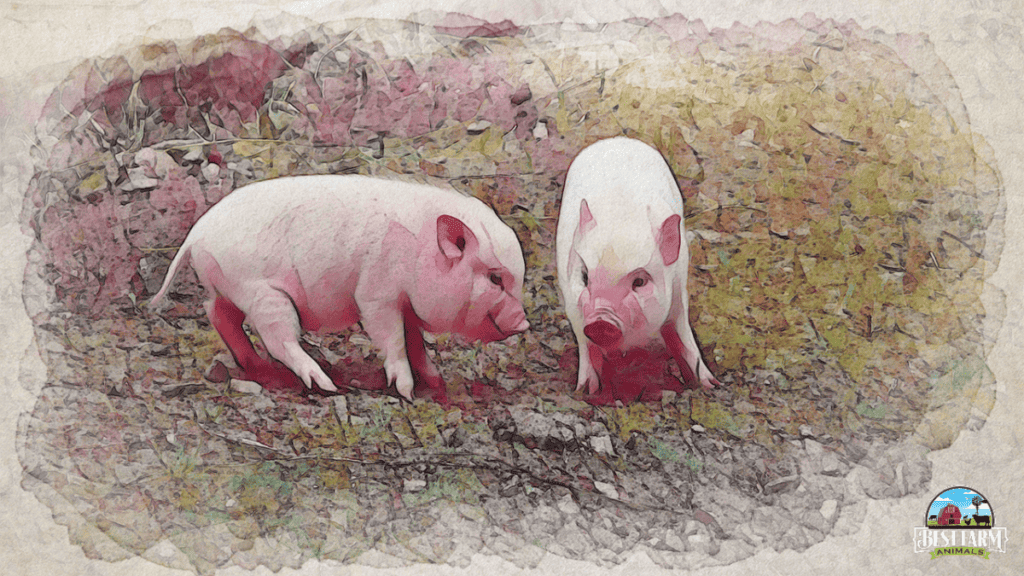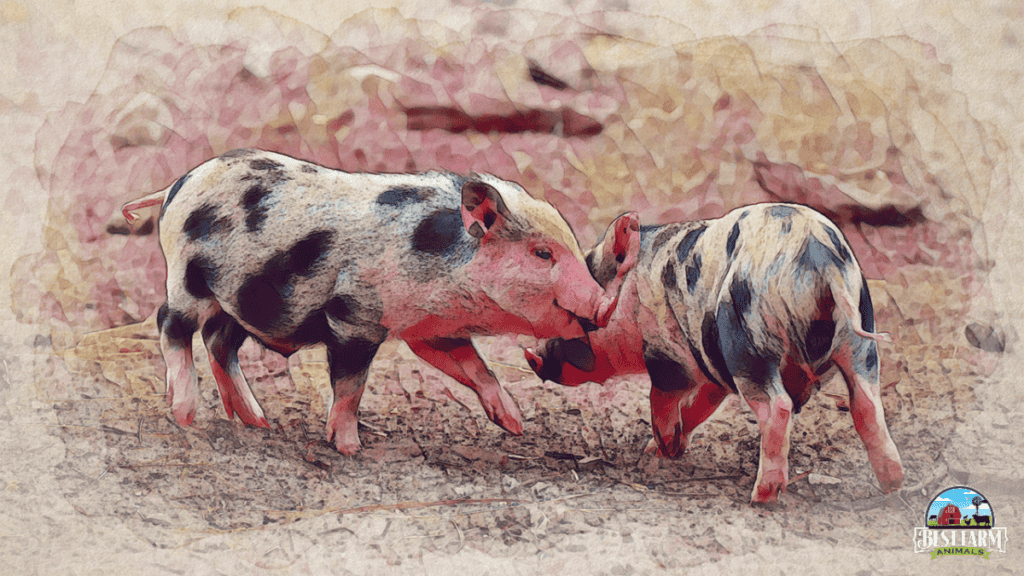Teacup pigs have taken the pet world by storm, captivating the hearts of animal lovers with their supposed miniature size and adorable appearances. These petite pigs have become an internet sensation from viral videos to social media feeds.
However, as the old saying goes, “Looks can be deceiving.” In this article, we delve into the world of teacup pigs. We’ll unravel the truth behind this phenomenon and shed light on the misconceptions surrounding these pint-sized porkers.
The allure of owning a tiny pig that can fit into a teacup is undoubtedly appealing. Who wouldn’t want a cute, compact pet pig that’s easy to care for?
Unfortunately, the reality of teacup pigs is far different from the fantasy. Contrary to popular belief, teacup pigs are not a real breed or a genetically modified creation. They are merely the result of clever marketing tactics and misrepresentation.

What are Teacup Pigs?
Teacup pigs, as the name suggests, are often portrayed as exceptionally small pig breeds that can fit snugly into a teacup or remain no larger than a small dog.
However, the reality is quite different. Teacup pigs, also known as micro pigs, pocket pigs, or miniature pigs, are not a recognized breed by any reputable animal registry or agricultural organization.
The term “teacup pig” is a marketing creation designed to evoke images of irresistibly tiny pigs that remain perpetually small. This clever marketing tactic has captured the attention of people seeking unique and compact pets, increasing demand for these supposed miniaturized pigs.
In truth, pigs are not naturally miniaturized to the extent portrayed by teacup pig enthusiasts. Regardless of their breed, pigs are mammals with genetic programming that determines their growth and size.
While some pig breeds naturally grow smaller than others, they still undergo a regular growth process and reach a mature size much larger than what is commonly associated with teacup pigs.
Teacup pigs are often advertised as staying small throughout their lives, with claims that they won’t exceed a certain weight or height. However, the reality is that teacup pigs can experience significant growth and reach sizes that far exceed their initial expectations.
Many individuals who purchase teacup pigs expecting them to remain small are often confronted with the challenge of caring for a full-sized pig that exceeds their living arrangements and capabilities.
It is crucial to understand that teacup pigs are not a distinct breed but rather a marketing ploy that capitalizes on the desire for tiny and unique pets. The true size and growth potential of pigs should be considered before committing to the ownership of any pig, to ensure their welfare and the ability to provide an appropriate living environment.
There Are Only 2 Ways to Create a “Teacup” Pig.
- Starve the pig so it remains constantly malnourished
- Inbreeding, which causes deformities of unnatural smallness
Starvation causes constant discomfort for your pig. It makes pigs more moody and unhealthy. It is simply cruel. Many “teacup” breeders even advise the new owners to ration the pig’s food so it stays underfed and doesn’t grow as it should.
This makes the skeletal structure of the pig small and weak. It also means the organs, which continue to grow, are disproportionate to the size of the pig, which brings all sorts of health issues.
Inbreeding causes many issues including respiratory issues, squished snouts, and a shorter lifespan. It also usually means other deformities in the pig, which greatly shortens the lifespan of the pig.
While pot-bellied pigs should live for 12+ years, most “teacup” pigs (really potbellied pigs) only live a few years due to health issues.
Miniature pigs are the name used for smaller big breeds that don’t reach the massive size of 800-1,000 lbs.
But, miniature pigs are not miniature. They still reach a whopping 200 lbs or more when fully grown. Before you purchase a miniature pig, be ready to handle a 200 lbs hog.
The Marketing Myth of Teacup Pigs
One of the primary tactics used in marketing teacup pigs is using selectively edited photos and videos. Cute images of piglets cradled in teacups or playing alongside small children create an appealing and heartwarming image.
These carefully staged visuals create an illusion of teacup pigs being permanently small and fit for any living environment. However, it’s crucial to remember that these are fleeting moments in the lives of pigs and do not accurately represent their long-term size or care requirements.
Furthermore, the term “teacup” itself is misleading. By associating pigs with teacups, the impression is created that they will remain tiny, akin to a teacup’s size.
You should question the sources of information when it comes to teacup pigs. Many sellers and breeders may use ambiguous or inaccurate terminology to describe their pigs. This makes it challenging to determine the actual breed, size, and growth potential of the animals they offer.
And the lack of standardized guidelines and regulations in the teacup pig industry makes it difficult to verify claims made by sellers, further perpetuating the marketing myth.
Ethical Concerns Of Teacup Pigs
Deceptive Marketing:
Teacup pig marketing involves deception, misleading buyers into believing they’re a distinct breed that stays small. But teacup pigs aren’t real and can’t be permanently stunted. Deceptive practices mislead and harm pet owners.
Unprepared Pig Owners
Teacup pig buyers often lack preparedness for long-term commitment. The misconception of small, low-maintenance pets leads to inadequate care. Growing pigs’ needs are overlooked, resulting in neglect, improper housing, and compromised welfare.
Abandonment and Rescue Shelters
Teacup pig trend leads to abandonment when pigs grow or demand more care. Shelters get overwhelmed, straining resources. Abandoned pigs expose lack of responsible ownership, compromising their well-being.
Health & Vet Concerns
Teacup pig breeding for small sizes ignores health risks. Irresponsible breeders may create genetically predisposed pigs. Inadequate nutrition and care from misinformed owners lead to obesity, malnutrition, and health complications.
Unfulfilled Emotional and Behavioral Needs
Teacup pig trend neglects emotional needs. Pigs need stimulation, social interaction, and suitable environments. Isolation and deprivation cause stress, anxiety, and behavioral issues, impacting well-being and human-pig interactions.
Before you buy a miniature pig: Many people think that if the parents of a pig are small- that’s a good indicator that the babies will be small.
But, that’s not true. Here’s why:
Pigs take up to 6 years to reach full-size, but they can breed as early as 6 months. So you can have piglet parents of other piglets that are small and still not full-sized. Looking at the parents doesn’t tell you if they are fully grown or how big your piglet will grow.
Teacup Pigs FAQs
Are teacup pigs a real breed?
Teacup pigs are not a recognized breed by reputable animal registries or agricultural organizations. The term “teacup” is a marketing creation, not an accurate description of a specific breed.
Can teacup pigs be kept as low-maintenance pets?
Teacup pigs are not low-maintenance pets. Like any other pigs, they require proper care, nutrition, space, and social interaction to thrive. Potential owners should be prepared for the long-term commitment and responsible ownership required.
Where can I find a reputable source for adopting a pig?
Reputable shelters and rescue organizations can be excellent sources for adopting pigs. They prioritize animal welfare and provide guidance on pig care. Research and reach out to these organizations to find a suitable pig for adoption.
Conclusion
Although the teacup pig phenomenon has captivated the public’s attention with its promise of permanently small and adorable pigs. But, teacup pigs do not defy the laws of nature. Pigs are not mere novelties or accessories; they deserve respect, care, and appropriate living conditions.
A great pig breed you might enjoy is the KuneKune Pig.
My Most Used Pig Supplies
This list contains affiliate products. Affiliate products do not cost more but helps to support BestFarmAnimals and our goal to provide farm animal owners with accurate and helpful information.
Purina Pig Chow will last well (or Mazuri is popular, but I haven’t tried it), and the stainless steel non-skid bowls that will help keep the mess down.
A pig blanket to keep her warm. This one also has bright colors and helps to provide rooting without the destruction.
Pig Harness for walking and handling your pig. There are a lot to choose from, but this one is pretty easy to use. If you want one that has a separate leash, this looks like a good one.
A large crate for keeping her safe in your house at night and when you leave the house. This is essential. You’ll also want a litterbox, and I like mine with a lid for nighttime. Pine shavings are best, and you may be able to find them in larger quantities locally.
When you have accidents, Odoban will help eliminate odors. When you are potty training, these floor pads work great for keeping your house clean while training her to go in certain places.
You’ll also want an outdoor house to keep her warm when she gets outside time, an essential part of her development.
Dewormer- Ivermectin is the primary dewormer I use, although I do rotate with a non-ivermect ingredient once so that the worms don’t get immune to it.

